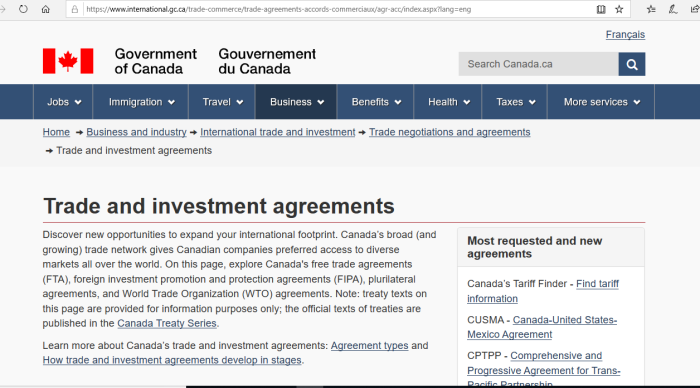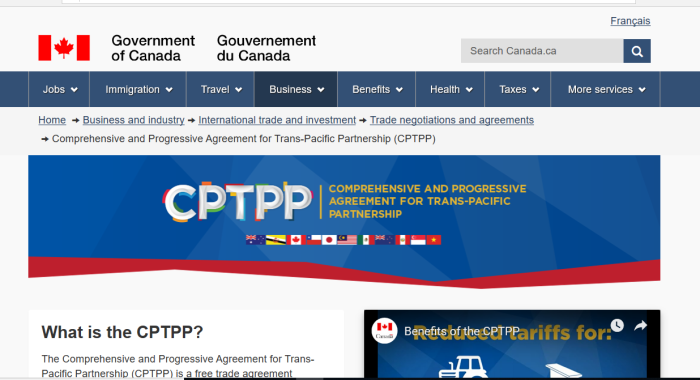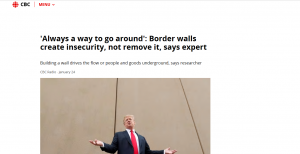



(Bev Collins & NAFTA)
https://www.youtube.com/watch?time_continue=241&v=KrhS2l0-rAE
1. Offshoring, Globalization, Free Trade
CLICK HERE, for #1: thoughts on potential free trade with China.
CLICK HERE, for #2: NAFTA, lawsuits, job losses, sovereignty.
CLICK HERE, for #3: looking at NAFTA’s hidden/ignored costs.
CLICK HERE, for #4: Bill C-79, Trans-Pacific Partnership.
CLICK HERE, for #5: why Trump abandoned the T.P.P.
CLICK HERE, for #6: CANZUK erasing our sovereignty.
2. Important Links
CLICK HERE, for the World Trade Organization (WTO), on the General Agreement on Tariffs and Trade (GATT)
CLICK HERE, for Canadian Gov’t trade deal listings.
CLICK HERE, for the modified version of T.P.P.
CLICK HERE, for Canada/Colombia FTA.
CLICK HERE, for Canada/Honduras FTA.
CLICK HERE, for Canada/Panama FTA.
CLICK HERE, for Canada/Korea FTA.
CLICK HERE, for CANZUK International.
3. Who’s Involved In Various Deals
(A) NAFTA includes: Mexico and the U.S.
(B) The Trans-Pacific Partnership includes: Australia, Brunei, Chile, Japan, Malaysia, Mexico, New Zealand, Peru, Singapore and Vietnam
(C) Canada-Colombia FTA includes: Colombia
(D) Canada-Honduras FTA includes: Honduras
(E) Canada-Panama FTA includes: Panama
(F) Canada-Korea FTA includes: S. Korea
(G) Commonwealth Free Movement (a.k.a “CANZUK”) includes:
-Anguilla
-Antigua
-The Bahamas
-Bangladesh
-Barbados
-Barbuda
-Belize
-Christmas Island
-the Cook Islands
-Guernsey
-India
-the Isle of Man
-Jamaica
-Jersey
-Nevis
-Nigeria
-Pakistan
-Papua New Guinea
-Saint Kitts
4. “National Treatment”, Chapter 11, NAFTA
The so-called “national treatment” provisions were a very harmful part of NAFTA, which was signed in 1995. It allowed governments and companies to sue other governments if their business plans or environmental laws were considered unprofitable. From Chapter 11 of NAFTA.
Article 1102: National Treatment
1. Each Party shall accord to investors of another Party treatment no less favorable than that it accords, in like circumstances, to its own investors with respect to the establishment, acquisition, expansion, management, conduct, operation, and sale or other disposition of investments.
2. Each Party shall accord to investments of investors of another Party treatment no less favorable than that it accords, in like circumstances, to investments of its own investors with respect to the establishment, acquisition, expansion, management, conduct, operation, and sale or other disposition of investments.
3. The treatment accorded by a Party under paragraphs 1 and 2 means, with respect to a state or province, treatment no less favorable than the most favorable treatment accorded, in like circumstances, by that state or province to investors, and to investments of investors, of the Party of which it forms a part.
4. For greater certainty, no Party may:
(a) impose on an investor of another Party a requirement that a minimum level of equity in an enterprise in the territory of the Party be held by its nationals, other than nominal qualifying shares for directors or incorporators of corporations; or
(b) require an investor of another Party, by reason of its nationality, to sell or otherwise dispose of an investment in the territory of the Party.
This clause has caused all sorts of headaches in the name of “free trade”. (See Free Trade #2 for more details). No longer are there countries, but merely “economic zones”. In the case of NAFTA
5. “National Treatment”, Article 9, T.P.P.
Now take a look at the Trans-Pacific Partnership. This was addressed in parts 4 and 5. The U.S., quite sensibly dumped this agreement, but Canada has signed on.
Article 9.4: National Treatment
1. Each Party shall accord to investors of another Party treatment no less favourable than that it accords, in like circumstances, to its own investors with respect to the establishment, acquisition, expansion, management, conduct, operation, and sale or other disposition of investments in its territory.
2. Each Party shall accord to covered investments treatment no less favourable than that it accords, in like circumstances, to investments in its territory of its own investors with respect to the establishment, acquisition, expansion, management, conduct, operation, and sale or other disposition of investments.
3. For greater certainty, the treatment to be accorded by a Party under paragraphs 1 and 2 means, with respect to a regional level of government, treatment no less favourable than the most favourable treatment accorded, in like circumstances, by that regional level of government to investors, and to investments of investors, of the Party of which it forms a part.
Look familiar? It should. It is virtually the identical language that formed the basis of lawsuits (many successful), in Canada. This can lead to the same issues that still happen in NAFTA, just on a bigger scale.
6. Chapter 2 of Canada/Colombia FTA
Section A – National Treatment
Article 202: National Treatment
1. Each Party shall accord national treatment to the goods of the other Party in accordance with Article III of the GATT 1994, and to this end Article III of the GATT 1994 is incorporated into and made part of this Agreement, mutatis mutandis.
2. The treatment to be accorded by a Party under paragraph 1 means, with respect to a sub-national government, treatment no less favorable than the most favorable treatment that sub-national government accords to any like, directly competitive or substitutable goods, as the case may be, of the Party of which it forms a part.
3. Paragraph 1 does not apply to the measures set out in Annex 202.
The agreement was signed in November 2008, and been in effect since August 2011.
7. Chapter 3 of Canada/Honduras FTA
Section B – National Treatment
Article 3.3: National Treatment
1. Each Party shall accord national treatment to the goods of the other Party in accordance with Article III of the GATT 1994, and to this end Article III of the GATT 1994 is incorporated into and made part of this Agreement.
2. The treatment to be accorded by a Party under paragraph 1 means, with respect to a sub-national government, treatment no less favourable than the most favourable treatment accorded by that sub-national government to a like, directly competitive, or substitutable good of the Party of which it forms a part. For the purposes of this paragraph, “goods of a Party” includes goods produced in the territory of the sub-national government of that Party.
3. Paragraphs 1 and 2 do not apply to a measure set out in Annex 3.3.
8. Chapter 2 of Canada/Panama FTA
Section I – National treatment
Article 2.03: National treatment
Each Party shall accord national treatment to the goods of the other Party in accordance with Article III of the GATT 1994, and to this end Article III of the GATT 1994 is incorporated into and made part of this Agreement.
The treatment to be accorded by a Party under paragraph 1 means, with respect to a sub-national government, treatment no less favourable than the most favourable treatment accorded by that sub-national government to a like, directly competitive or substitutable good, as the case may be, of the Party of which it forms a part.
Paragraphs 1 and 2 do not apply to a measure set out in Annex 2.03 (Exceptions to Articles 2.03 and 2.08).
9. Chapter 2 of Canada/S. Korea FTA
Section A – National Treatment
Article 2.2: National Treatment
1. Each Party shall accord national treatment to the goods of the other Party in accordance with Article III of the GATT 1994 and, for greater certainty, its interpretative notes, and to this end Article III of the GATT 1994 and, for greater certainty, its interpretative notes, or an equivalent provision of a successor agreement to which both Parties are party, are incorporated into and made part of this Agreement.
2. The treatment to be accorded by a Party pursuant to paragraph 1 means, with respect to a sub-national government, treatment no less favourable than the most favourable treatment that sub-national government accords to like, directly competitive or substitutable goods of the Party of which it forms a part.
3. Paragraph 1 does not apply to the measures set out in Annex 2-A.
Yes, the wordings here are identical. National treatment is a clause that prevents another country from taking any protectionist measures in order to protect its people.
Why should we care? Because many of these countries Canada has signed agreements with are able to produce goods at a much lower cost. As such, Canadian manufacturers are forced to compete with the third world. This has the effect of outsourcing jobs, and driving down the wages of jobs that remain.
These agreements are just a few. Please go through the more of the index.
10. Commonwealth Freedom of Movement Organisation (Now “CANZUK”)
Note: This initiative is for both free trade, and free movement — a.k.a. erasing borders.
Originally the group was known as the Commonwealth Freedom of Movement Organisation, and were working towards open borders between nations of the British Commonwealth. It was later renamed CANZUK International (Canada, Australia, New Zealand, United Kingdom), most likely as it would be an easier sell.
It should be said that a new Commonwealth union would be welcoming of any potential members – with each being considered on a case-by-case basis – and that the CANZUK project is very much a work in progress; always receptive of fresh ideas and potential avenues to explore.
A useful way to begin is by taking a look at the CANZUK countries’ dependent territories, such as Christmas Island, the Cook Islands and Anguilla, for example, which are dependencies of Australia, New Zealand, and the UK, respectively, as well as the UK’s Crown dependencies (Guernsey, Jersey, and the Isle of Man).
Each area would naturally become full members of the new group along with the nations to which they are related. Some advocates claim that these small islands, and their generally sparse populations, are currently under-utilised, and that a CANZUK alliance would offer a tremendous opportunity for their communities to acquire a far more extensive set of rights by becoming equal partners in a union, while shaking off their somewhat colonial tint.
Widening our scope, we arrive at the Commonwealth realms. These realms are sovereign states who are members of the Commonwealth and who currently share Queen Elizabeth II as their monarch, of which, there are 16 including the CANZUK countries.
Although the rest of the realms are far less developed than their CANZUK counterparts, and while the new partnership wouldn’t act as a sort of transfer union, they would still enjoy a huge range of economic benefits. Unrestricted work and travel, as well as increased investment in transport and communications infrastructure, would make these tropical environments rather more attractive to potential tourists and retirees.
But, whether founded or not, the notion that free immigration was causing problems for the UK was undoubtedly a primary motivation for its departure from the European Union. A CANZUK union would seek to avoid such issues by moving slowly and steadily with the original four members, providing economic assistance to the realms before allowing their eventual membership.
A further concern, and no doubt the most pressing, is that a union involving most or all of the current Commonwealth would be a political impossibility, with almost every country having broken off colonial ties with the British in order to achieve their independence, which says nothing for the relationships between some of the nations (India and Pakistan or Bangladesh and Pakistan, for example). Of course, it would be entirely possible for individual Commonwealth countries to make a solo membership claim.
When weighing up the potential barriers to entry that many of these Commonwealth countries have, we’re often confronted with the challenge that this new alliance is concerned only with nations that are populated by white folk. Such criticism is fairly lazy and can be easily dealt with. Firstly, as we’ve just seen, there’s absolutely no reason why these countries couldn’t join in the future, so long as efforts were directed at bringing them up to par in the ways just discussed.
All in all, while some of the future membership candidates do carry some weight, it should be pretty clear that the original CANZUK coalition is by far the most practical place to begin. The innumerable similarities between these four countries is really where the magic of this movement will happen.
At first, the project will be challenging enough, and caution will be required. Having said that, and as previously mentioned, CANZUK’s immense potential truly knows no bounds, and, down the line, further options can always be explored.
Let’s be clear: the 4 members (Canada, Australia, New Zealand, United Kingdom) are just the starting point. This group has every intention of opening it up to other nations.
Even if there is only the free trade agreement (no replacement migration), it would still be a killer for Canadian jobs. We can’t possibly compete against nations which are able to produce so cheaply.
11. How Does This Help Our People?
As outlined in previous articles, so-called “free trade” agreements end up outsourcing jobs to the 3rd world, which can produce goods much more cheaply.
Jobs that remain are often lower wage, as employers are now forced to compete with far cheaper foreign players. It creates an incentive for even more employers to outsource, further eliminating jobs.
While touted as economic liberty and economy growing, such deals cause havoc to communities. It’s no comfort to people who suddenly find themselves unemployed.


